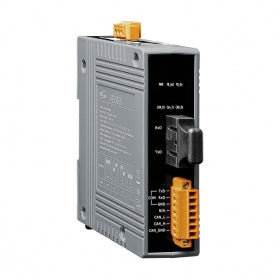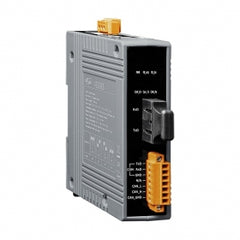

I-2533CS CAN-Bus to Single-Mode Fibre Optic Bridge
- £211.00
- £211.00
- (-0%)
- Unit price
- per
CAN bridge used to establish a connection between two CAN bus system via single mode fiber optic transmission
Subtotal:
£211.00
Couldn't load pickup availability
Free Shipping
Free standard shipping on orders over £500
Free Returns
30 Day Money Back Guarantee
Description
xThe I-2533CS is a local CAN bridge used to establish a connection between two CAN bus system via single mode fiber optic transmission medium. In order to solve the problem between CAN and fiber transmission medium, the I-2533CS is specially designed for converting the electrical CAN bus signal to fiber optic cables. I-2533CS has three more important features. First, the transmission distance limitation of the CAN bus system will not affected due to the different CAN baud rate. It means that the total CAN bus working distance can be extended. Second, the bus error on one CAN network will not affect the operation of another CAN network. Finally, the two CAN network can communication with each other by using different CAN baud rate for highly flexibility.
The I-2533CS series is designed for single mode fiber, and allow to extern CAN bus to maximum 30 km. Besides, I-2533CS provides the group function, which is the basic message router. Users can decide the CAN message flows between several CAN bus systems. I-2533CS series also provides the utility tool for user-defined baud rate and filter configuration. By using this tool, it is allowed to have user-defined baud rate and CAN message filter. When users use the I-2533CS series on two CAN network with different CAN baud rate, it may be useful to reduce the bus loading of the network which has low baud rate.
Features
x- Fiber Type: SC ; Single mode ; 100 Base-FX
- Maximum transmission distance up to 30 km at any CAN baud rate
- NXP TJA1042 CAN transceiver
- 2500 Vrms isolation on the CAN side
- Supports both CAN 2.0A and CAN 2.0B
- Fully compatible with the ISO 11898-2 standard
- Rotary switch for CAN baud rate configuration
- Build-in switch for 120 Ω terminal resistor
- Removable terminal block, Mount easily on DIN-Rail
- Allows user-defined CAN baud rate
- Fiber broken line detection
- Utility tool for CAN message filter configuration
- The CAN port with the same Group ID can communicate with each other
Specifications
x| LED Indicators | |
|---|---|
| Status | 1 x Power 3 x CAN status 2 x Fiber status |
| COM Ports | |
|---|---|
| Ports | 1 x RS-232 (Utility Port) |
| Fiber | |
|---|---|
| Ports | Single-Mode; SC Duplex connector x 1; 100 Base-FX |
| Fiber Cable | 8.3/125, 8.7/125, 9/125 or 10/125 μm |
| Wavelength | 1310 nm |
| TX Output | -15 dBmMin. , -8 dBm Max. |
| RX Sensitivity | -34 dBm Max. |
| RX Overload | -5 dBm Max. |
| Budget | 19 dBm |
| Propagation Delay | 190 us (*Note1) |
| Distance Between Stations | 30 km (9/125 μm recommended) |
| CAN | |
|---|---|
| Ports | 1 |
| Baud Rate | 10 k ~ 1 M bps |
| Isolation | 500 Vrms on the CAN side |
| Terminal Resistor | Switch for 120Ω terminal resistor |
| Specification | ISO 11898-2, CAN 2.0A and CAN 2.0B |
| Filter | Yes |
| Power | |
|---|---|
| Input Range | +10 VDC ~ +30 VDC |
| Consumption | 3 W |
| Mechanical | |
|---|---|
| Casing | Plastic |
| Dimensions (mm) | 33 x 126 x 101 (W x L x H) |
| Installation | DIN-Rail |
| Environment | |
|---|---|
| Operating Temperature | -25 ~ +75 °C |
| Storage Temperature | -30 ~ +80 °C |
| Humidity | 10 ~ 90% RH, Non-condensing |
Specification Memo
Note1: The propagation delay depends on the CAN Bus baud rate and the CAN message format. This value has been tested using a CAN baud rate of 1 Mbps, the CAN ID 0x12345678 and 8 bytes of data with a value of 0xFF.
Applications
xRelated Products
Example product title
- £211.00
- £211.00
- (-0%)
- Unit price
- per
Example product title
- £211.00
- £211.00
- (-0%)
- Unit price
- per
Example product title
- £211.00
- £211.00
- (-0%)
- Unit price
- per
Example product title
- £211.00
- £211.00
- (-0%)
- Unit price
- per
Example product title
- £211.00
- £211.00
- (-0%)
- Unit price
- per
Example product title
- £211.00
- £211.00
- (-0%)
- Unit price
- per
Example product title
- £211.00
- £211.00
- (-0%)
- Unit price
- per
Example product title
- £211.00
- £211.00
- (-0%)
- Unit price
- per
Example product title
- £211.00
- £211.00
- (-0%)
- Unit price
- per
Example product title
- £211.00
- £211.00
- (-0%)
- Unit price
- per
Recently Viewed Products
Example product title
- £211.00
- £211.00
- (-0%)
- Unit price
- per
Example product title
- £211.00
- £211.00
- (-0%)
- Unit price
- per
Example product title
- £211.00
- £211.00
- (-0%)
- Unit price
- per
Example product title
- £211.00
- £211.00
- (-0%)
- Unit price
- per
Example product title
- £211.00
- £211.00
- (-0%)
- Unit price
- per
Example product title
- £211.00
- £211.00
- (-0%)
- Unit price
- per
Example product title
- £211.00
- £211.00
- (-0%)
- Unit price
- per
Example product title
- £211.00
- £211.00
- (-0%)
- Unit price
- per
Example product title
- £211.00
- £211.00
- (-0%)
- Unit price
- per
Example product title
- £211.00
- £211.00
- (-0%)
- Unit price
- per
- Choosing a selection results in a full page refresh.

